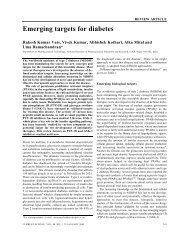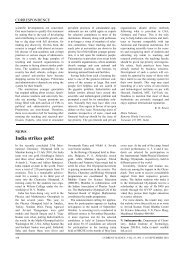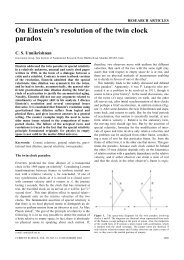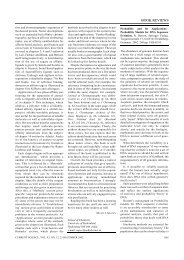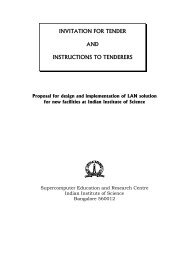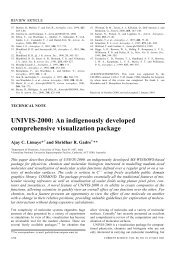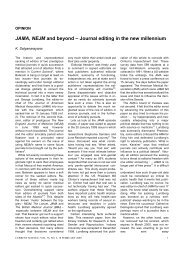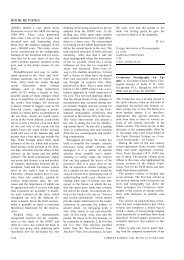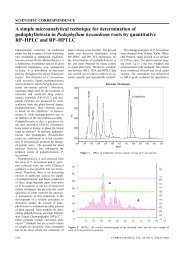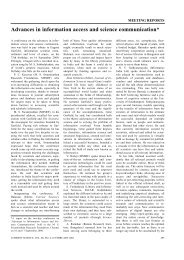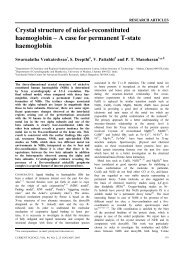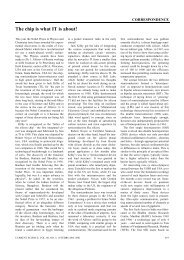Impact of bark removal on survival of Taxus baccata L ... - Index of
Impact of bark removal on survival of Taxus baccata L ... - Index of
Impact of bark removal on survival of Taxus baccata L ... - Index of
You also want an ePaper? Increase the reach of your titles
YUMPU automatically turns print PDFs into web optimized ePapers that Google loves.
RESEARCH COMMUNICATIONS<br />
<str<strong>on</strong>g>Impact</str<strong>on</strong>g> <str<strong>on</strong>g>of</str<strong>on</strong>g> <str<strong>on</strong>g>bark</str<strong>on</strong>g> <str<strong>on</strong>g>removal</str<strong>on</strong>g> <strong>on</strong> <strong>survival</strong> <str<strong>on</strong>g>of</str<strong>on</strong>g><br />
<strong>Taxus</strong> <strong>baccata</strong> L. (Himalayan yew) in<br />
Nanda Devi Biosphere Reserve,<br />
Garhwal Himalaya, India<br />
Aditya Purohit † , R. K. Maikhuri †,* , K. S. Rao ‡ and<br />
S. Nautiyal ‡<br />
† Sustainable Development <str<strong>on</strong>g>of</str<strong>on</strong>g> Rural Ecosystem, G.B. Pant Institute <str<strong>on</strong>g>of</str<strong>on</strong>g><br />
Himalayan Envir<strong>on</strong>ment and Development, Garhwal Unit, P.B. 92,<br />
Srinagar (Garhwal) 246 174, India<br />
‡ Sustainable Development <str<strong>on</strong>g>of</str<strong>on</strong>g> Rural Ecosystem, G.B. Pant Institute <str<strong>on</strong>g>of</str<strong>on</strong>g><br />
Himalayan Envir<strong>on</strong>ment and Development, Kosi-Katarmal,<br />
Almora 263 643, India<br />
The Himalayan yew (<strong>Taxus</strong> <strong>baccata</strong> L.) is widely but<br />
sparsely distributed al<strong>on</strong>g the cool temperate belt<br />
between 2600 and 3300 m asl <str<strong>on</strong>g>of</str<strong>on</strong>g> the Nanda Devi Biosphere<br />
Reserve (NDBR), Garhwal Himalaya. Traditi<strong>on</strong>ally,<br />
the <str<strong>on</strong>g>bark</str<strong>on</strong>g> <str<strong>on</strong>g>of</str<strong>on</strong>g> this plant is used for preparing<br />
beverages locally called Namkin Chay, medicines and<br />
its wood as a timber in various regi<strong>on</strong>s <str<strong>on</strong>g>of</str<strong>on</strong>g> the Himalaya.<br />
However, due to its excessive collecti<strong>on</strong> for use in<br />
anti-tumour and anti-cancer drugs, the populati<strong>on</strong> <str<strong>on</strong>g>of</str<strong>on</strong>g><br />
this species has been reduced to a large extent. A study<br />
carried out between April 1997 and October 2000<br />
showed that the trees with average girth <str<strong>on</strong>g>of</str<strong>on</strong>g> 10–90 cm<br />
were damaged through <str<strong>on</strong>g>bark</str<strong>on</strong>g>-stripping practices. The<br />
average c<strong>on</strong>sumpti<strong>on</strong> and collecti<strong>on</strong> <str<strong>on</strong>g>of</str<strong>on</strong>g> the <str<strong>on</strong>g>bark</str<strong>on</strong>g> was<br />
estimated to be 1.7 kg/family/year in the buffer z<strong>on</strong>e<br />
villages <str<strong>on</strong>g>of</str<strong>on</strong>g> NDBR. It was noticed that the growth and<br />
<strong>survival</strong> <str<strong>on</strong>g>of</str<strong>on</strong>g> this species declined significantly when the<br />
<str<strong>on</strong>g>bark</str<strong>on</strong>g> was removed bey<strong>on</strong>d a limit <str<strong>on</strong>g>of</str<strong>on</strong>g> average <str<strong>on</strong>g>bark</str<strong>on</strong>g><br />
thickness (0.43 cm). Since <str<strong>on</strong>g>bark</str<strong>on</strong>g> collecti<strong>on</strong> is an important<br />
traditi<strong>on</strong>al activity and directly linked with the<br />
health and livelihood <str<strong>on</strong>g>of</str<strong>on</strong>g> the local people, it cannot be<br />
banned or stopped. It is suggested that if <str<strong>on</strong>g>bark</str<strong>on</strong>g>removing<br />
practices are applied appropriately with<br />
minimum depth <str<strong>on</strong>g>of</str<strong>on</strong>g> 0.2–0.3 cm from around the circumference<br />
<str<strong>on</strong>g>of</str<strong>on</strong>g> the trees (> 40 cm cbh trunk) in<br />
a scattered manner, there will be minimum harmful<br />
effect <strong>on</strong> growth and <strong>survival</strong> <str<strong>on</strong>g>of</str<strong>on</strong>g> the trees. This paper<br />
describes the indigenous uses <str<strong>on</strong>g>of</str<strong>on</strong>g> <strong>Taxus</strong> <strong>baccata</strong>, impact<br />
<str<strong>on</strong>g>of</str<strong>on</strong>g> <str<strong>on</strong>g>bark</str<strong>on</strong>g> <str<strong>on</strong>g>removal</str<strong>on</strong>g> <strong>on</strong> <strong>survival</strong> and appropriate strategies<br />
for c<strong>on</strong>servati<strong>on</strong>/management <str<strong>on</strong>g>of</str<strong>on</strong>g> this species.<br />
TAXUS <strong>baccata</strong> L., Himalayan yew, locally known as<br />
‘Thuner’ in various parts <str<strong>on</strong>g>of</str<strong>on</strong>g> the Western Himalaya, has<br />
greater ec<strong>on</strong>omic and medicinal values than the other<br />
gymnosperms in the regi<strong>on</strong>. <strong>Taxus</strong> as an understorey tree<br />
is found in temperate forests in the Pacific, north-west <str<strong>on</strong>g>of</str<strong>on</strong>g><br />
North America, East Asia, North Africa and Europe 1–4 . In<br />
India it is widely distributed in the temperate z<strong>on</strong>e <str<strong>on</strong>g>of</str<strong>on</strong>g><br />
Himalaya between 1800 and 3300 m above mean sea<br />
level 1 . It is a late successi<strong>on</strong>al species and grows in its<br />
*For corresp<strong>on</strong>dence. (e-mail: rkmaikhuri@yahoo.com)<br />
586<br />
natural habitat in Nanda Devi Biosphere Reserve<br />
(NDBR), Garhwal Himalaya, particularly <strong>on</strong> the north–<br />
north-west slopes. It is closely associated with Betula<br />
utiliz, Abies pindrow, Acer caesium and Pinus wallichiana,<br />
and also found in small patches under the Quercus semecarpifolia<br />
and Rhododendr<strong>on</strong> arboreum associati<strong>on</strong> in<br />
other parts <str<strong>on</strong>g>of</str<strong>on</strong>g> the Himalaya 5 . T. <strong>baccata</strong> received much<br />
attenti<strong>on</strong> during the recent past because its leaves and<br />
<str<strong>on</strong>g>bark</str<strong>on</strong>g> are the prime source <str<strong>on</strong>g>of</str<strong>on</strong>g> taxol, a potent anti-cancer<br />
drug 6–8 . Taxol was first isolated from the <str<strong>on</strong>g>bark</str<strong>on</strong>g> <str<strong>on</strong>g>of</str<strong>on</strong>g> <strong>Taxus</strong><br />
brevifolia 9 , but in India and other parts <str<strong>on</strong>g>of</str<strong>on</strong>g> the world<br />
pharmaceutical companies have succeeded in isolating<br />
it from the leaves. The presence <str<strong>on</strong>g>of</str<strong>on</strong>g> taxol has also been<br />
examined in the leaves, stem and <str<strong>on</strong>g>bark</str<strong>on</strong>g> <str<strong>on</strong>g>of</str<strong>on</strong>g> several <strong>Taxus</strong><br />
species, including T. <strong>baccata</strong> 10 . In the Unani system <str<strong>on</strong>g>of</str<strong>on</strong>g><br />
medicine, the extract from the <str<strong>on</strong>g>bark</str<strong>on</strong>g> and leaves <str<strong>on</strong>g>of</str<strong>on</strong>g> T.<br />
<strong>baccata</strong> was the source <str<strong>on</strong>g>of</str<strong>on</strong>g> a drug Zarnab, used for the<br />
treatment <str<strong>on</strong>g>of</str<strong>on</strong>g> various disorders 1 . The paste prepared from<br />
its <str<strong>on</strong>g>bark</str<strong>on</strong>g> is applied as a plaster <strong>on</strong> fractured b<strong>on</strong>e. It is also<br />
applied externally <strong>on</strong> the forehead to provide relief from<br />
headache 11 . The extract from the <str<strong>on</strong>g>bark</str<strong>on</strong>g> and leaves is also<br />
used for the treatment <str<strong>on</strong>g>of</str<strong>on</strong>g> various diseases like br<strong>on</strong>chitis,<br />
asthma, pois<strong>on</strong>ous insect bites and also as an aphrodisiac<br />
12 . The inhabitants <str<strong>on</strong>g>of</str<strong>on</strong>g> the buffer z<strong>on</strong>e villages <str<strong>on</strong>g>of</str<strong>on</strong>g><br />
NDBR have been collecting the <str<strong>on</strong>g>bark</str<strong>on</strong>g> <str<strong>on</strong>g>of</str<strong>on</strong>g> T. <strong>baccata</strong> mainly<br />
for making traditi<strong>on</strong>al tea and for curing cold and<br />
cough, for a l<strong>on</strong>g time. Tolchha and Marcha Bhotia subcommunities<br />
<str<strong>on</strong>g>of</str<strong>on</strong>g> NDBR and other traditi<strong>on</strong>al societies <str<strong>on</strong>g>of</str<strong>on</strong>g><br />
the Himalaya used its leaves for thatching and wood<br />
carving, house c<strong>on</strong>structi<strong>on</strong> and for the preparati<strong>on</strong> <str<strong>on</strong>g>of</str<strong>on</strong>g><br />
h<strong>on</strong>ey-bee shelter 13 . However, during the recent past, due<br />
to over-exploitati<strong>on</strong> <str<strong>on</strong>g>of</str<strong>on</strong>g> this species legally or illegally for<br />
a variety <str<strong>on</strong>g>of</str<strong>on</strong>g> purposes, it is facing danger <str<strong>on</strong>g>of</str<strong>on</strong>g> extincti<strong>on</strong> in<br />
different regi<strong>on</strong>s 13–15 .<br />
The main reas<strong>on</strong>s for the decline <str<strong>on</strong>g>of</str<strong>on</strong>g> yew populati<strong>on</strong>s<br />
globally are widespread deforestati<strong>on</strong>, selective felling<br />
<str<strong>on</strong>g>of</str<strong>on</strong>g> yew and grazing 2,16,17 . T. <strong>baccata</strong> is very sensitive to<br />
forest fire and easily dries with ground fire 18 . Degradati<strong>on</strong><br />
<str<strong>on</strong>g>of</str<strong>on</strong>g> old populati<strong>on</strong>s and low regenerati<strong>on</strong> in its natural<br />
habitat are the main problems in the c<strong>on</strong>servati<strong>on</strong> <str<strong>on</strong>g>of</str<strong>on</strong>g><br />
T. <strong>baccata</strong>. Therefore, the present study was undertaken<br />
(i) to understand the patterns <str<strong>on</strong>g>of</str<strong>on</strong>g> its uses, quantify the <str<strong>on</strong>g>bark</str<strong>on</strong>g><br />
extracti<strong>on</strong>/collecti<strong>on</strong> and its impact <strong>on</strong> <strong>survival</strong>; and (ii) to<br />
develop strategies for c<strong>on</strong>servati<strong>on</strong> and management in its<br />
natural habitats.<br />
The study area is located in the buffer z<strong>on</strong>e <str<strong>on</strong>g>of</str<strong>on</strong>g> NDBR<br />
<str<strong>on</strong>g>of</str<strong>on</strong>g> Garhwal regi<strong>on</strong> (Central Himalaya). NDBR is situated<br />
between 30°17′N and 30°41′N latitude and 79°40′E and<br />
80°05′E l<strong>on</strong>gitude and covers an area <str<strong>on</strong>g>of</str<strong>on</strong>g> 624.62 km 2 core<br />
z<strong>on</strong>e and 1612.12 km 2 buffer z<strong>on</strong>e. Recently, the total<br />
area <str<strong>on</strong>g>of</str<strong>on</strong>g> the NDBR has been increased from 2336.74 km 2<br />
to 5800 km 2 (Figure 1). The climate <str<strong>on</strong>g>of</str<strong>on</strong>g> the area is typically<br />
temperate, m<strong>on</strong>so<strong>on</strong>al and divisible into three<br />
seas<strong>on</strong>s, i.e. l<strong>on</strong>g winter, short summer and rainy. Average<br />
rainfall is 929 mm. About 47% <str<strong>on</strong>g>of</str<strong>on</strong>g> annual rainfall occurs<br />
over a short period <str<strong>on</strong>g>of</str<strong>on</strong>g> two m<strong>on</strong>ths (July and August).<br />
CURRENT SCIENCE, VOL. 81, NO. 5, 10 SEPTEMBER 2001
RESEARCH COMMUNICATIONS<br />
M<strong>on</strong>thly maximum and minimum temperature ranges<br />
between 24°–14°C and 7.5°–3°C, respectively. The area<br />
is geo-morphologically young and tect<strong>on</strong>ically active 19 .<br />
Geologically, parent material is crystalline rocks, including<br />
mica schist, garnet mica quartz schist and mica quartz.<br />
The soil is generally friable, black-to-brown in colour,<br />
loam-to-sandy loam and well-drained. Frozen ice soil is<br />
also found in the valley or deep-shaded places in the<br />
m<strong>on</strong>ths <str<strong>on</strong>g>of</str<strong>on</strong>g> April and May.<br />
The people in these villages bel<strong>on</strong>g to two ethnic<br />
groups, viz. Indo-M<strong>on</strong>goloid (Bhotiya tribals) and Indo-<br />
Aryan. The people inhabiting the buffer z<strong>on</strong>e villages <str<strong>on</strong>g>of</str<strong>on</strong>g><br />
NDBR located in the Chamoli part bel<strong>on</strong>g to the Tolchha<br />
community, which is <strong>on</strong>e <str<strong>on</strong>g>of</str<strong>on</strong>g> the three sub-communities <str<strong>on</strong>g>of</str<strong>on</strong>g><br />
the Bhotiyas. Except the residents <str<strong>on</strong>g>of</str<strong>on</strong>g> Reni, Peng, Lata and<br />
Tolma villages, all Tolchha–Bhotiya households have two<br />
permanent dwellings, <strong>on</strong>e in the high altitudes between<br />
2400 and 3500 m asl and other in the lower valleys<br />
(outside the buffer z<strong>on</strong>e <str<strong>on</strong>g>of</str<strong>on</strong>g> NDBR) between 800 and<br />
1500 m asl. This community has its own culture, traditi<strong>on</strong><br />
and religious beliefs. The major occupati<strong>on</strong> <str<strong>on</strong>g>of</str<strong>on</strong>g> this community<br />
has been sheep rearing and agriculture, with the<br />
latter gaining importance over pastoralism in c<strong>on</strong>temporary<br />
time. The total number <str<strong>on</strong>g>of</str<strong>on</strong>g> households in ten buffer<br />
z<strong>on</strong>e villages (Chamoli part) was 419, with a total populati<strong>on</strong><br />
<str<strong>on</strong>g>of</str<strong>on</strong>g> 2253 <str<strong>on</strong>g>of</str<strong>on</strong>g> which 872 were adult male, 721 were<br />
adult female and 752 were children below 15 years <str<strong>on</strong>g>of</str<strong>on</strong>g> age.<br />
The average family size was 5–6 pers<strong>on</strong>s. In 2000–<br />
3500 m asl elevati<strong>on</strong> z<strong>on</strong>e, rainfed cultivati<strong>on</strong> <strong>on</strong> terraced<br />
slopes is the comm<strong>on</strong> agricultural land use. Almost all the<br />
households are involved in agriculture through subsistence<br />
farming. Livestock comprises cows, bullocks,<br />
sheep, goat, horses and mules. The average number <str<strong>on</strong>g>of</str<strong>on</strong>g><br />
animals per family was 19.5. All the households depend<br />
entirely <strong>on</strong> forests for fuel, fodder, timber and leaf litter<br />
for organic manure. Many plant species are used in traditi<strong>on</strong>al<br />
health care system.<br />
A study has been carried out over a period <str<strong>on</strong>g>of</str<strong>on</strong>g> three<br />
years (April 1997 to October 2000) in the natural habitat<br />
<str<strong>on</strong>g>of</str<strong>on</strong>g> the T. <strong>baccata</strong> as well as in the buffer z<strong>on</strong>e villages <str<strong>on</strong>g>of</str<strong>on</strong>g><br />
NDBR. In nature, the T. <strong>baccata</strong> populati<strong>on</strong> regenerates<br />
through seeds 1 . Seeds are surrounded by red, fleshy edible<br />
aril, have a l<strong>on</strong>g range <str<strong>on</strong>g>of</str<strong>on</strong>g> dispersal by means <str<strong>on</strong>g>of</str<strong>on</strong>g> birds,<br />
m<strong>on</strong>keys and sometimes through humans too. Seeds also<br />
Figure 1.<br />
Map <str<strong>on</strong>g>of</str<strong>on</strong>g> Nanda Devi Biosphere Reserve with new additi<strong>on</strong>.<br />
CURRENT SCIENCE, VOL. 81, NO. 5, 10 SEPTEMBER 2001 587
RESEARCH COMMUNICATIONS<br />
Table 1. Average <strong>Taxus</strong> <strong>baccata</strong> <str<strong>on</strong>g>bark</str<strong>on</strong>g> collecti<strong>on</strong> kg/family/yr (X – ± SD) <strong>on</strong> dry weight basis for preparati<strong>on</strong><br />
<str<strong>on</strong>g>of</str<strong>on</strong>g> traditi<strong>on</strong>al tea by the buffer z<strong>on</strong>e villagers <str<strong>on</strong>g>of</str<strong>on</strong>g> NDBR. Values in parenthesis are the number <str<strong>on</strong>g>of</str<strong>on</strong>g><br />
households surveyed in the study area<br />
Family class Small (1–4 pers<strong>on</strong>s) Medium (5–8 pers<strong>on</strong>s) Large (> 8 pers<strong>on</strong>s)<br />
Poor 0.868 ± 0.256 (35) 1.233 ± 0.348 (45) 2.8 ± 0.204 (10)<br />
Medium 0.911 ± 0.3 (42) 1.406 ± 0.459 (70) 2.23 ± 0.46 (15)<br />
Rich – 1.825 ± 0.33 (15) 2.3 ± 0.23 (8)<br />
germinate in open canopy site between the forests, but do<br />
not survive. Low regenerati<strong>on</strong> and recruitment <str<strong>on</strong>g>of</str<strong>on</strong>g> this species<br />
are because <str<strong>on</strong>g>of</str<strong>on</strong>g> grazing by goats, chilling injury, direct<br />
sunlight and fire, which are comm<strong>on</strong> in the Himalayan<br />
regi<strong>on</strong>. Data were collected to assess the c<strong>on</strong>sumpti<strong>on</strong><br />
pattern <str<strong>on</strong>g>of</str<strong>on</strong>g> T. <strong>baccata</strong> <str<strong>on</strong>g>bark</str<strong>on</strong>g> used for traditi<strong>on</strong>al purposes by<br />
the Bhotiya tribal community. Anthropogenic pressure<br />
was also assessed, particularly <strong>on</strong> its <str<strong>on</strong>g>bark</str<strong>on</strong>g>, in the forest in<br />
terms <str<strong>on</strong>g>of</str<strong>on</strong>g> removed <str<strong>on</strong>g>bark</str<strong>on</strong>g> quantity (g/tree <strong>on</strong> dry weight<br />
basis) for different girth classes (10–50 cm and 50–<br />
90 cm cbh, i.e. circumference at breast height) during the<br />
study period. Besides, the total quantity <str<strong>on</strong>g>of</str<strong>on</strong>g> <str<strong>on</strong>g>bark</str<strong>on</strong>g> collected<br />
and c<strong>on</strong>sumed throughout the year by local people was<br />
quantified during the year <strong>on</strong> the basis <str<strong>on</strong>g>of</str<strong>on</strong>g> pers<strong>on</strong>al observati<strong>on</strong>s<br />
and by adopting weight survey method 20 , in about<br />
240 households which represent 60% <str<strong>on</strong>g>of</str<strong>on</strong>g> the total buffer<br />
z<strong>on</strong>e villages. During the observati<strong>on</strong> period, we visited<br />
each sampled household to collect informati<strong>on</strong> <strong>on</strong> the<br />
amount <str<strong>on</strong>g>of</str<strong>on</strong>g> T. <strong>baccata</strong> <str<strong>on</strong>g>bark</str<strong>on</strong>g> collected for the year. The<br />
dried <str<strong>on</strong>g>bark</str<strong>on</strong>g> was weighed using a top pan balance with the<br />
capacity <str<strong>on</strong>g>of</str<strong>on</strong>g> <strong>on</strong>e kg. All these households were surveyed<br />
and grouped into three categories, i.e. (a) small family<br />
(with 1–4 members); (b) medium family (5–8 members);<br />
and (c) large family (> 8 members). These families were<br />
also categorized (viz. poor, medium and rich) based <strong>on</strong><br />
their income earned through various sources as well as<br />
based <strong>on</strong> land holding, number and kinds <str<strong>on</strong>g>of</str<strong>on</strong>g> animals<br />
owned and employment status.<br />
The two sites, each <str<strong>on</strong>g>of</str<strong>on</strong>g> 2 ha forests plots represented by<br />
T. <strong>baccata</strong> populati<strong>on</strong> and other associated species, i.e. B.<br />
utiliz, P. wallichiana, A. pindrow and Populus ciliata,<br />
was selected near Lata and Tolama villages to assess<br />
the impact <str<strong>on</strong>g>of</str<strong>on</strong>g> <str<strong>on</strong>g>bark</str<strong>on</strong>g> <str<strong>on</strong>g>removal</str<strong>on</strong>g> <strong>on</strong> its <strong>survival</strong>. In each <str<strong>on</strong>g>of</str<strong>on</strong>g> the<br />
two sites, 5 transects (100 m length, 10 m width) al<strong>on</strong>g<br />
the slope were laid. Each transect was divided into 10<br />
plots <str<strong>on</strong>g>of</str<strong>on</strong>g> 10 m × 10 m size and in each plot, girth at breast<br />
height (i.e. 1.30 m above ground level) and the number <str<strong>on</strong>g>of</str<strong>on</strong>g><br />
trees (cbh > 31.5 cm) were measured. Within a plot, <strong>on</strong>e<br />
quadrat <str<strong>on</strong>g>of</str<strong>on</strong>g> 5 m × 5 m was randomly laid to enumerate<br />
saplings (height > 20 cm and cbh < 31.5 cm) and within<br />
this, <strong>on</strong>e quadrat <str<strong>on</strong>g>of</str<strong>on</strong>g> 1 m × 1 m was randomly laid for<br />
enumerati<strong>on</strong> <str<strong>on</strong>g>of</str<strong>on</strong>g> seedlings (height < 20 cm). Frequency,<br />
density and basal area values were calculated. Importance<br />
value index (IVI) was derived as a sum <str<strong>on</strong>g>of</str<strong>on</strong>g> relative frequency,<br />
relative density and relative basal area for each<br />
species 21 .<br />
588<br />
Figure 2. <strong>Taxus</strong> <strong>baccata</strong> tree from which a complete strip <str<strong>on</strong>g>of</str<strong>on</strong>g> <str<strong>on</strong>g>bark</str<strong>on</strong>g><br />
was removed around the circumference.<br />
Before initiating this study, a meeting was organized in<br />
these two villages and the villagers were requested to<br />
visit the area for <str<strong>on</strong>g>bark</str<strong>on</strong>g> collecti<strong>on</strong> in the presence <str<strong>on</strong>g>of</str<strong>on</strong>g> the<br />
researchers. Frequent visits, <strong>on</strong>ce in a m<strong>on</strong>th between<br />
April and October al<strong>on</strong>g with villagers to the study site<br />
were made to assess the actual quantity <str<strong>on</strong>g>of</str<strong>on</strong>g> <str<strong>on</strong>g>bark</str<strong>on</strong>g> removed<br />
and to see the process <str<strong>on</strong>g>of</str<strong>on</strong>g> de<str<strong>on</strong>g>bark</str<strong>on</strong>g>ing practised by the local<br />
people. From November to March, villagers usually do<br />
not collect the <str<strong>on</strong>g>bark</str<strong>on</strong>g> because <str<strong>on</strong>g>of</str<strong>on</strong>g> heavy snowfall in the area.<br />
It was noticed that the <str<strong>on</strong>g>bark</str<strong>on</strong>g> is removed from the main tree<br />
trunk in a different manner at various depths, which vary<br />
in quantity am<strong>on</strong>g the individuals. The volume <str<strong>on</strong>g>of</str<strong>on</strong>g><br />
removed <str<strong>on</strong>g>bark</str<strong>on</strong>g> was estimated by measuring area and depth<br />
<str<strong>on</strong>g>of</str<strong>on</strong>g> <str<strong>on</strong>g>bark</str<strong>on</strong>g> <strong>on</strong> de<str<strong>on</strong>g>bark</str<strong>on</strong>g>ed trees; 30 individuals from different<br />
CURRENT SCIENCE, VOL. 81, NO. 5, 10 SEPTEMBER 2001
RESEARCH COMMUNICATIONS<br />
girth classes were chosen. The measured volume <str<strong>on</strong>g>of</str<strong>on</strong>g><br />
removed <str<strong>on</strong>g>bark</str<strong>on</strong>g> was c<strong>on</strong>verted into g/tree <strong>on</strong> dry weight<br />
basis and was averaged for two groups <str<strong>on</strong>g>of</str<strong>on</strong>g> girth classes,<br />
i.e. 10–50 and 50–90 cm.<br />
An assessment was made to observe <strong>survival</strong> percentage<br />
<str<strong>on</strong>g>of</str<strong>on</strong>g> T. <strong>baccata</strong> tree, particularly am<strong>on</strong>g those individuals<br />
from which the <str<strong>on</strong>g>bark</str<strong>on</strong>g> was removed at various depths,<br />
i.e. up to 2 mm, 4 mm, 6 mm, and > 8 mm or bey<strong>on</strong>d the<br />
maximum limit <str<strong>on</strong>g>of</str<strong>on</strong>g> <str<strong>on</strong>g>bark</str<strong>on</strong>g> depth. Al<strong>on</strong>g with depth, de<str<strong>on</strong>g>bark</str<strong>on</strong>g>ed<br />
area (25%, 50% 75% and > 75% around the circumference<br />
up to a height <str<strong>on</strong>g>of</str<strong>on</strong>g> 2 m above the ground or depending<br />
<strong>on</strong> tree bole straightness) was also c<strong>on</strong>sidered to assess its<br />
impact <strong>on</strong> <strong>survival</strong>. The observati<strong>on</strong>s were made for different<br />
girth classes from which the <str<strong>on</strong>g>bark</str<strong>on</strong>g> was removed.<br />
The total (dried, uprooted and de<str<strong>on</strong>g>bark</str<strong>on</strong>g>ed) tree density <str<strong>on</strong>g>of</str<strong>on</strong>g><br />
T. <strong>baccata</strong> ranged between 50 and 62 trees/ha. The average<br />
collecti<strong>on</strong> <str<strong>on</strong>g>of</str<strong>on</strong>g> <str<strong>on</strong>g>bark</str<strong>on</strong>g> per family per year was about<br />
1.7 ± 0.318 kg dry weight (Table 1). Large-size families,<br />
bel<strong>on</strong>ging to all the income groups collect maximum <str<strong>on</strong>g>bark</str<strong>on</strong>g><br />
compared to medium and small size families, throughout<br />
the year. Families <str<strong>on</strong>g>of</str<strong>on</strong>g> the poor income group totally<br />
depend <strong>on</strong> <str<strong>on</strong>g>bark</str<strong>on</strong>g> <str<strong>on</strong>g>of</str<strong>on</strong>g> T. <strong>baccata</strong> for tea all around the year,<br />
whereas rich families do not c<strong>on</strong>sume all the <str<strong>on</strong>g>bark</str<strong>on</strong>g> they<br />
have collected but distribute them to their kin living outside,<br />
particularly in the plains. While working <strong>on</strong> this<br />
aspect we found that there is no organized market available<br />
for selling <strong>Taxus</strong> <str<strong>on</strong>g>bark</str<strong>on</strong>g> in the area. However, due to<br />
the demand illegal extracti<strong>on</strong>s are going <strong>on</strong>.<br />
The <str<strong>on</strong>g>bark</str<strong>on</strong>g> <str<strong>on</strong>g>of</str<strong>on</strong>g> T. <strong>baccata</strong> was peeled <str<strong>on</strong>g>of</str<strong>on</strong>g>f from the main<br />
stem up to the height <str<strong>on</strong>g>of</str<strong>on</strong>g> 50–250 cm (depending <strong>on</strong> tree<br />
bole) from the ground, with the help <str<strong>on</strong>g>of</str<strong>on</strong>g> sharp sickle<br />
(Figure 2). The quantity <str<strong>on</strong>g>of</str<strong>on</strong>g> <str<strong>on</strong>g>bark</str<strong>on</strong>g> removed from the tree<br />
was measured as an average volume <str<strong>on</strong>g>of</str<strong>on</strong>g> 825 cm 3 /tree<br />
which is equal to 436 g dry weight for 10–50 cm girth<br />
classes and 1624 cm 3 /tree (966 g) for trees with 50–90 cm<br />
girth classes. The effect <str<strong>on</strong>g>of</str<strong>on</strong>g> de<str<strong>on</strong>g>bark</str<strong>on</strong>g>ing and browsing <strong>on</strong> T.<br />
<strong>baccata</strong> is poorly known though it is very susceptible to<br />
browsing and <str<strong>on</strong>g>bark</str<strong>on</strong>g>-stripping by deer and has a str<strong>on</strong>g<br />
negative effect <strong>on</strong> recruitment and mature tree <strong>survival</strong> 22–25 .<br />
Similar effect has been observed <strong>on</strong> T. <strong>baccata</strong> trees in<br />
NDBR, where <str<strong>on</strong>g>bark</str<strong>on</strong>g>-stripping has been d<strong>on</strong>e with the help<br />
<str<strong>on</strong>g>of</str<strong>on</strong>g> a sharp sickle by inhabitants <str<strong>on</strong>g>of</str<strong>on</strong>g> the buffer z<strong>on</strong>e villages<br />
for traditi<strong>on</strong>al uses. They peeled <str<strong>on</strong>g>of</str<strong>on</strong>g>f the <str<strong>on</strong>g>bark</str<strong>on</strong>g> from the<br />
trunk as a whole girdle <str<strong>on</strong>g>of</str<strong>on</strong>g> <str<strong>on</strong>g>bark</str<strong>on</strong>g> around the circumference<br />
or sometimes also in a scattered manner. During the<br />
study, it was also noticed (not m<strong>on</strong>itored) that the browsing<br />
<str<strong>on</strong>g>of</str<strong>on</strong>g> <strong>Taxus</strong> seedlings by livestock, particularly sheep<br />
and goats was comm<strong>on</strong>, and had a negative impact <strong>on</strong> the<br />
growth <str<strong>on</strong>g>of</str<strong>on</strong>g> the seedlings.<br />
Per cent <strong>survival</strong> after removing the <str<strong>on</strong>g>bark</str<strong>on</strong>g> from the trunk<br />
in different girth classes as well as at different thicknesses<br />
and areas is presented in Figure 3. Am<strong>on</strong>g the de<str<strong>on</strong>g>bark</str<strong>on</strong>g>ed T.<br />
<strong>baccata</strong> trees, <strong>survival</strong> was maximum when the <str<strong>on</strong>g>bark</str<strong>on</strong>g> was<br />
removed to a depth <str<strong>on</strong>g>of</str<strong>on</strong>g> 0.2 cm in a scattered manner. The<br />
maximum decline in <strong>survival</strong> was observed in those trees<br />
from which the <str<strong>on</strong>g>bark</str<strong>on</strong>g> was removed bey<strong>on</strong>d the limit <str<strong>on</strong>g>of</str<strong>on</strong>g><br />
25% 50% 75% More than 75%<br />
120%<br />
At 10-50cm cbh <str<strong>on</strong>g>of</str<strong>on</strong>g> trees<br />
At 50-90cm cbh <str<strong>on</strong>g>of</str<strong>on</strong>g> trees<br />
100%<br />
80%<br />
Survival (%)<br />
60%<br />
40%<br />
20%<br />
0%<br />
2mm 4mm 6mm 2mm 4mm 6mm<br />
Removed Bark thickness (mm)<br />
Figure 3. Survival percentage <str<strong>on</strong>g>of</str<strong>on</strong>g> <strong>Taxus</strong> <strong>baccata</strong> after removing <str<strong>on</strong>g>bark</str<strong>on</strong>g> from the tree trunk in different<br />
harvesting regimes.<br />
CURRENT SCIENCE, VOL. 81, NO. 5, 10 SEPTEMBER 2001 589
RESEARCH COMMUNICATIONS<br />
average <str<strong>on</strong>g>bark</str<strong>on</strong>g> thickness (0.43 cm) or as a whole ring <strong>on</strong> the<br />
trunk. The effect <str<strong>on</strong>g>of</str<strong>on</strong>g> girdling <strong>on</strong> the tree trunk by removing<br />
<str<strong>on</strong>g>bark</str<strong>on</strong>g> from around the circumference was observed and it<br />
was noticed that the <str<strong>on</strong>g>bark</str<strong>on</strong>g> below the girdle dried and eventually<br />
died, which ultimately affects the growth and <strong>survival</strong><br />
<str<strong>on</strong>g>of</str<strong>on</strong>g> the tree. Removal <str<strong>on</strong>g>of</str<strong>on</strong>g> <str<strong>on</strong>g>bark</str<strong>on</strong>g> (phloem) from the tree<br />
trunk usually blocks the translocati<strong>on</strong> <str<strong>on</strong>g>of</str<strong>on</strong>g> materials, which<br />
is necessary for healthy growth and <strong>survival</strong> 26–28 . Depth <str<strong>on</strong>g>of</str<strong>on</strong>g><br />
<str<strong>on</strong>g>bark</str<strong>on</strong>g> removed is an important factor for the poor growth<br />
<str<strong>on</strong>g>of</str<strong>on</strong>g> the tree, because <strong>on</strong>ce the <str<strong>on</strong>g>bark</str<strong>on</strong>g> is stripped-<str<strong>on</strong>g>of</str<strong>on</strong>g>f up to the<br />
cortex, the remaining part <str<strong>on</strong>g>of</str<strong>on</strong>g> the <str<strong>on</strong>g>bark</str<strong>on</strong>g> <strong>on</strong> the tree automatically<br />
splits up, even up to the top crown. Besides,<br />
<str<strong>on</strong>g>bark</str<strong>on</strong>g>-removing practices applied appropriately with minimum<br />
depth <str<strong>on</strong>g>of</str<strong>on</strong>g> 0.2–0.3 cm from around the circumference<br />
<str<strong>on</strong>g>of</str<strong>on</strong>g> the trees (> 40 cm cbh trunk) in a scattered manner,<br />
will have minimum harmful effect <strong>on</strong> growth and <strong>survival</strong><br />
<str<strong>on</strong>g>of</str<strong>on</strong>g> the trees.<br />
We have not found any correlati<strong>on</strong> between <str<strong>on</strong>g>bark</str<strong>on</strong>g><br />
<str<strong>on</strong>g>removal</str<strong>on</strong>g> depth and families <str<strong>on</strong>g>of</str<strong>on</strong>g> different income groups<br />
and sizes. Earlier, when there was not much demand traditi<strong>on</strong>ally,<br />
local people <str<strong>on</strong>g>of</str<strong>on</strong>g> the regi<strong>on</strong> used to collect/extract<br />
the <str<strong>on</strong>g>bark</str<strong>on</strong>g> usually from mature trees or trees with good<br />
growth, so as to not harm the trees. But, during the recent<br />
past, due to its legal or illegal extracti<strong>on</strong> other than traditi<strong>on</strong>al<br />
uses, people do not even spare saplings or juvenile<br />
trees, which has a negative impact <strong>on</strong> the <strong>survival</strong> and<br />
growth <str<strong>on</strong>g>of</str<strong>on</strong>g> this species.<br />
<strong>Taxus</strong> has very less or negative resp<strong>on</strong>se to recovery or<br />
recruitment <strong>on</strong>ce the <str<strong>on</strong>g>bark</str<strong>on</strong>g> is peeled-<str<strong>on</strong>g>of</str<strong>on</strong>g>f in a strip or as a<br />
whole ring from the trunk. The local populati<strong>on</strong> <str<strong>on</strong>g>of</str<strong>on</strong>g> NDBR<br />
buffer z<strong>on</strong>e villages has been using <str<strong>on</strong>g>bark</str<strong>on</strong>g> <str<strong>on</strong>g>of</str<strong>on</strong>g> <strong>Taxus</strong> in traditi<strong>on</strong>al<br />
tea to cope with very cold climatic c<strong>on</strong>diti<strong>on</strong>s <str<strong>on</strong>g>of</str<strong>on</strong>g> the<br />
area, for a l<strong>on</strong>g time. Since <str<strong>on</strong>g>bark</str<strong>on</strong>g> collecti<strong>on</strong> is an important<br />
traditi<strong>on</strong>al activity and directly linked with the health and<br />
livelihood <str<strong>on</strong>g>of</str<strong>on</strong>g> the people, it cannot be stopped or banned.<br />
However, in view <str<strong>on</strong>g>of</str<strong>on</strong>g> its large-scale collecti<strong>on</strong> legally or<br />
illegally, the people <str<strong>on</strong>g>of</str<strong>on</strong>g> the regi<strong>on</strong> should be made aware<br />
through c<strong>on</strong>servati<strong>on</strong> and envir<strong>on</strong>mental educati<strong>on</strong> programmes<br />
<str<strong>on</strong>g>of</str<strong>on</strong>g> sustainable harvest <str<strong>on</strong>g>of</str<strong>on</strong>g> <str<strong>on</strong>g>bark</str<strong>on</strong>g> and the harmful<br />
effect <str<strong>on</strong>g>of</str<strong>on</strong>g> de<str<strong>on</strong>g>bark</str<strong>on</strong>g>ing or girdling <strong>on</strong> the trees. Efforts in this<br />
directi<strong>on</strong> are in progress. The regenerati<strong>on</strong> and c<strong>on</strong>servati<strong>on</strong><br />
<str<strong>on</strong>g>of</str<strong>on</strong>g> <strong>Taxus</strong> could be improved if all beneficiaries <str<strong>on</strong>g>of</str<strong>on</strong>g> the<br />
area participate and jointly act to protect, manage and<br />
adopt sustainable and appropriate techniques for the<br />
extracti<strong>on</strong>/collecti<strong>on</strong> <str<strong>on</strong>g>of</str<strong>on</strong>g> <str<strong>on</strong>g>bark</str<strong>on</strong>g> and other useful parts.<br />
1. An<strong>on</strong>., The Wealth <str<strong>on</strong>g>of</str<strong>on</strong>g> India, Publicati<strong>on</strong> and Informati<strong>on</strong> Directorate,<br />
CSIR, New Delhi, 1976, vol. X, p. 591.<br />
2. Tittensor, R. M., Biol. C<strong>on</strong>serv., 1980, 17, 243–265.<br />
3. Watt, G., A Dicti<strong>on</strong>ary <str<strong>on</strong>g>of</str<strong>on</strong>g> the Ec<strong>on</strong>omic Products <str<strong>on</strong>g>of</str<strong>on</strong>g> India,<br />
Gordhan and Company, Delhi, 1989, vol. 6, part 3, p. 479.<br />
4. Lewandowsky, A., Burczyk, J. and Mejnartowicz L., For. Ecol.<br />
Manage., 1995, 73, 221–227.<br />
5. Singh, J. S. and Singh, S. P., Forests <str<strong>on</strong>g>of</str<strong>on</strong>g> Himalaya: Structure<br />
Functi<strong>on</strong>ing and <str<strong>on</strong>g>Impact</str<strong>on</strong>g> <str<strong>on</strong>g>of</str<strong>on</strong>g> Man, Gyanodaya Prakashan, Nainital,<br />
1992.<br />
6. Kral, R., Isoetaceae through Euphorbiaceae, USDA Forest<br />
Service, Atlanta, Georgia, 1983, vol. 1.<br />
7. Busing, R T., Charls, B. H. and Thomas, A. S., C<strong>on</strong>serv. Biol.,<br />
1995, 9, 1199–1207.<br />
8. Nemeeck, S., Sci. Am., 1996, 10.<br />
9. Wani, M. C. and Taylor, H. L., J. Am. Chem. Soc., 1976, 93,<br />
1325–1327.<br />
10. Witherup, R. M., Look S. A., Slasko, M. W., Ghiorji, T. J., Muschik<br />
G. M. and Gragg, G. M., J. Nat. Prod., 1990, 53, 1294–1255.<br />
11. Gaur, R. D., Flora <str<strong>on</strong>g>of</str<strong>on</strong>g> the District Garhwal North West Himalaya<br />
with Ethnobotanical Notes, Trans Media, Srinagar (Garhwal),<br />
1999, p. 48.<br />
12. Beckstrom-Sternberg S. M. and Duke, J. A., Internati<strong>on</strong>al Yew<br />
Resource C<strong>on</strong>ference, Berkeley, USA, 1993, p. 3.<br />
13. Maikhuri, R. K., Nautiyal, S. and Rao, K. S., Curr. Sci., 1998, 75,<br />
152–157.<br />
14. Gamble, J. S., A Manual <str<strong>on</strong>g>of</str<strong>on</strong>g> Indian Timbers, Simps<strong>on</strong> Low, Mast<strong>on</strong><br />
and Company Limited, L<strong>on</strong>d<strong>on</strong>, 1992, p. 868.<br />
15. Nandi, S. K., Rikhari, H. C., Nadeem, M. and Palni, L. M. S.,<br />
Physiol. Mol. Biol. Plant, 1997, 3, 15–24.<br />
16. Bugala, W., in The Yew–<strong>Taxus</strong> <strong>baccata</strong> L. (ed. Bialobok, S.),<br />
Foreign Scientific Publicati<strong>on</strong>s, Department <str<strong>on</strong>g>of</str<strong>on</strong>g> the Nati<strong>on</strong>al Center<br />
for Scientific, Technical and Ec<strong>on</strong>omic Informati<strong>on</strong>, Warsaw,<br />
Poland, 1978, pp. 15–32.<br />
17. Jahn, G., in Temperate Deciduous Forests (eds Rohrig, E., Ulrich,<br />
B.), Elsevier, Amsterdam, 1991, vol. 7, pp. 377–502.<br />
18. Mc Cune, B. and Allen, T. F. H., Can. J. Bot., 1985, 63, 377–383.<br />
19. Valdiya, K. S., Geology <str<strong>on</strong>g>of</str<strong>on</strong>g> Kumaun Lesser Himalaya, Wadia Institute<br />
<str<strong>on</strong>g>of</str<strong>on</strong>g> Himalayan Geology, Dehradun, 1980.<br />
20. Maikhuri, R. K., Bior. Techn., 1991, 35, 291–296.<br />
21. Curtis, J. T. and McIntosh, R. P., Ecology, 1950, 46, 84–89.<br />
22. Haeggstrom, C. A., Acta Bot. Fenn., 1990, 141, 1–28.<br />
23. Gill, R. M. A., Gurnell, J. and Trout, R. C., in The Ecology <str<strong>on</strong>g>of</str<strong>on</strong>g><br />
Woodland Creati<strong>on</strong> (ed. Ferris Khan, R.), Wiley, Chichester,<br />
1995, pp. 201–224.<br />
24. Kelley, D. L., J. Ecol., 1981, 69, 437–472.<br />
25. Sarmaja-Korj<strong>on</strong>en, K., Vasary, Y. and Haeggstrom, C. A., Acta<br />
Bot. Fenn., 1991, 28, 143–159.<br />
26. Mas<strong>on</strong>, T. G. and Maskell, E. J., Ann. Bot. 1928, 42, 189.<br />
27. Zimmermann, M. H., Science, 1961, 133, 73–79.<br />
28. Zimmermann, M. H. and Milburn, J. A., in Encyclopaedia <str<strong>on</strong>g>of</str<strong>on</strong>g><br />
Plant Physiology (eds Pirs<strong>on</strong>, A. and Zimmermann, M. H.),<br />
Springer-Verlag, Berlin, 1975, New Series, vol. I.<br />
ACKNOWLEDGEMENTS. We are thankful to Dr L. M. S. Palni,<br />
Director, G.B. Pant Institute <str<strong>on</strong>g>of</str<strong>on</strong>g> Himalayan Envir<strong>on</strong>ment and Development,<br />
Kosi-Katarmal, Almora for facilities. Financial support from the<br />
Ministry <str<strong>on</strong>g>of</str<strong>on</strong>g> Envir<strong>on</strong>ment & Forests, Indian Council <str<strong>on</strong>g>of</str<strong>on</strong>g> Agriculture<br />
Research and Department <str<strong>on</strong>g>of</str<strong>on</strong>g> Biotechnology, Govt. <str<strong>on</strong>g>of</str<strong>on</strong>g> India is thankfully<br />
acknowledged. The views/opini<strong>on</strong>s expressed in this article are<br />
those <str<strong>on</strong>g>of</str<strong>on</strong>g> the authors and not necessarily <str<strong>on</strong>g>of</str<strong>on</strong>g> the affiliated organizati<strong>on</strong>.<br />
Received 26 December 2000; revised accepted 8 June 2001<br />
590<br />
CURRENT SCIENCE, VOL. 81, NO. 5, 10 SEPTEMBER 2001



